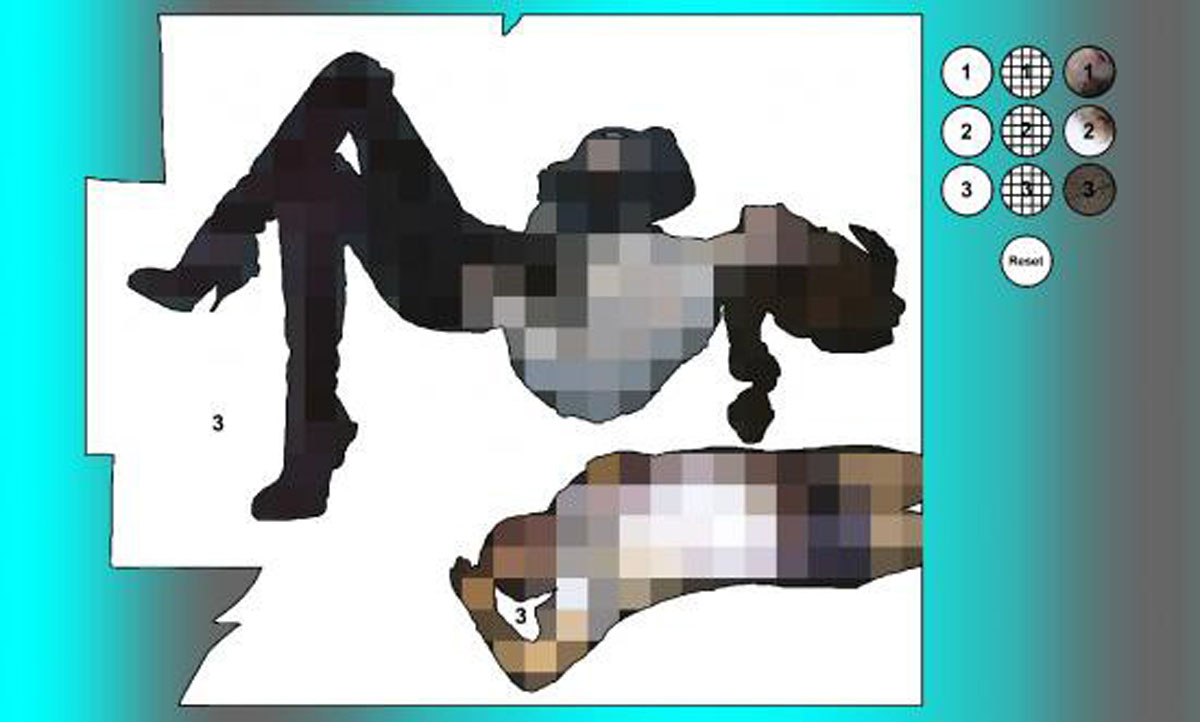Thomas Hirschhorn: Self-Pixel
“Self-pixel” comes from “Pixel-Collage”, my most recent works and engagement with the problematic of pixelation. My statement is that pixelation is not a technique, not a system but a decision.
In association with its pre-launch programming, Remai Modern invited artists to realize original projects exclusively for online viewing. Through these commissions, the museum considered its website as an extension of its physical space and onsite program. Mobile and experimental, this online gallery allowed for direct, personal encounters with art while connecting artists and audiences across the globe.
From 2016-2020, the museum presented projects by: Ryan Gander, Tammi Campbell, Tanya Lukin Linklater, Thomas Hirschhorn, Taysir Batniji, Pedro Barateiro, Kara Uzleman, Rosa Barba, Amanda Beech, Ellen Moffat, Duane Linklater, Lynne Marsh, Raqs Media Collective, Ahlam Shibli, Ann Lislegaard, Anton Vidokly, Dave McKenzie, Laakkuluk Williamson-Bathory and Kelly Nipper.
Putting or removing each pixel — or even cutting it into smaller pixel parts — is a decision. It’s a political decision. I believe that ‘pixelation’ or blurring, masking and furthermore censorship or self-censorship, is a growing and insidious problematic, also in regard the new social medias. Obviously I don’t accept what has been pixelated in my place ‘to protect me’ and obviously don’t pixelate what is usually concealed and meant to be removed, to frustrate, censor or make non-visible.
Therefore in the new Pixel-Collage”, I want to show pixelation or blurring in its abstract aesthetic and question: How can abstraction be understood today? How can abstraction, through pixelation, engage me in today’s world, time and reality? How can I redefine my idea of abstraction today? I want to integrate the growing phenomena of facelessness in pictures today. What interests me specifically about this aesthetic of facelessness, is its formal embodiment through pixelation. More and more common in the media, the “Pixelation” phenomenon shows us that, in order to be authentic, a picture needs to be pixelated or partly pixelated. Pixelating has taken over the role of authenticity. A pixelated picture is surely authentic if it has unacceptable areas which are concealed while the acceptable is not pixelated. It is interesting to observe that the use of pixels follows no common law at all. Partly pixelated pictures look even more authentic and are accepted as such by viewers. It therefore seems clear that pixels stand for authentication: Authentication through authority. And, in our chaotic, incommensurable, contradictory and complex world there is a huge demand for authority. Pixels deliver an aesthetic to this demand for authority, for protection and for de-responsabilization.
I understand abstraction as thinking, as political thinking. Pixels in their abstraction build up a new form, opening towards a dynamic and desire of truth, truth as such, truth as something reaching beyond information, non-information or counter-information. The point is to understand how an existing published picture can become an abstraction. It seems to me that — paradoxically — the authoritarian will to use pixelation in order to hide, to ‘protect’, not show, or not make something visible has, instead, become an invitation or possibility to touch truth. Truth through pixels, through their abstraction and the aesthetic of their abstraction. To touch truth does not mean verifying information, to touch truth is an act of emancipation.
The political thinking and form of my “Pixel-Collage” is the belief in abstraction, and the belief in the aesthetic of pixelation. This means giving a response – through Form – to the question “How can abstraction be understood today?” With my works “Pixel-Collage” and “New Pixel-Collage”, “Pixel-Video” and “Self-Pixel” I want to give Form, and in giving Form I must show what I see, what I understand, what comes from myself without explanation or argumentation. Nothing is un-showable. What cannot be shown is what has no form. Everything that is ‘form’ is showable and viewable — even when incommensurable. Everything that has a form in this incommensurable world must remain incommensurable, without attempt of becoming commensurable from not being shown or keeping our eyes shut. In order to confront the world, to struggle with its chaos, its incommensurability, in order to coexist and cooperate in this world and with the other, I need to confront reality without distance. Today, more than ever, I need to see everything with my own eyes in our one world, and no one can tell me what my eyes should see, or not.
“Self-Pixel” means acting with your own eyes.
Thomas Hirschhorn, Aubervilliers, summer 2016
“
Thomas Hirschhorn (b. 1957, Bern, Switzerland) studied at the Schule für Gestaltung Zürich from 1978 to 1983 and moved to Paris in 1983, where he has been living since. His work has been shown in numerous museums, galleries and exhibitions including the Venice Biennale (1999 and 2015); documenta11 (2002); 27th São Paolo Biennale (2006); 55th Carnegie International, Pittsburgh (2008); the Swiss Pavilion at the 54th Venice Biennale (2011); La Triennale, Palais de Tokyo, Paris (2012); 9th Shanghai Biennale (2012); Gladstone Gallery New York (2012); Manifesta 10, St. Petersburg (2014); Atopolis Mons, Belgium (2015); and South London Gallery (2015).
Hirschhorn’s “Presence and Production” projects include Gramsci Monument (2013), the Bronx, New York; Flamme éternelle (2014), Palais de Tokyo, Paris; and Bijlmer Spinoza Festival (2009), Amsterdam, among others. The book Gramsci Monument was published in 2015 by Dia Art Foundation and Koenig Books. A selection of the artist’s writings has been published in English in Critical Laboratory: The Writings of Thomas Hirschhorn (MIT Press, 2013); and French in Une volonté de faire, Thomas Hirschhorn (Éditions Macula, 2015).
With each exhibition, in museums, galleries or alternative spaces, or with specific works in public space, Thomas Hirschhorn asserts his commitment toward a non-exclusive public. The artist has received awards and prizes including Preis für Junge Schweizer Kunst (1999), Marcel Duchamp Prize (2000), Roland Prize for Public Art (2003), Joseph Beuys Prize (2004) and Kurt Schwitters Prize (2011).
